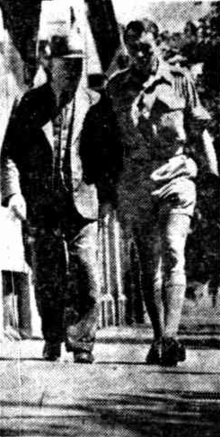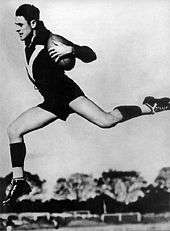Haydn Bunton Sr.
| Haydn Bunton Sr. | |||
|---|---|---|---|
 | |||
| Personal information | |||
| Full name | Haydn William Bunton | ||
| Date of birth | 5 July 1911 | ||
| Place of birth | Albury, New South Wales | ||
| Date of death | 5 September 1955 (aged 44) | ||
| Place of death | Adelaide, South Australia | ||
| Original team(s) | Albury | ||
| Height | 179 cm (5 ft 10 in) | ||
| Weight | 73 kg (161 lb) | ||
| Position(s) | Rover | ||
| Playing career1 | |||
| Years | Club | Games (Goals) | |
| 1931–1937, 1942 | Fitzroy | 119 (207) | |
| 1938–1941 | Subiaco | 72 (190) | |
| 1945 | Port Adelaide | 17 (30) | |
| Representative team honours | |||
| Years | Team | Games (Goals) | |
| 1931–1937 | Victoria | 12 | |
| 1938–1939 | Western Australia | ||
| Coaching career3 | |||
| Years | Club | Games (W–L–D) | |
| 1936 | Fitzroy | 18 (2–16–0) | |
| 1947–1948 | North Adelaide | 35 (13–21–0) | |
|
1 Playing statistics correct to the end of 1945. 3 Coaching statistics correct as of 1948. | |||
| Career highlights | |||
|
VFL
WAFL
SANFL
Honours
| |||
| Sources: AFL Tables, AustralianFootball.com | |||
Haydn William Bunton (5 July 1911 – 5 September 1955) was an Australian rules footballer who represented Fitzroy in the Victorian Football League (VFL), Subiaco in the West Australian Football League (WAFL), and Port Adelaide in the South Australian National Football League (SANFL) during the 1930s and 1940s.
Bunton is the only footballer to have won the Brownlow Medal and the Sandover Medal three times each. He is one of only four footballers to have won the Brownlow three times (the others being Ian Stewart, Dick Reynolds and Bob Skilton), and one of only five footballers to have won the Sandover at least three times (the others being Bill Walker, who won it four times; and Barry Cable, Graham Farmer and Merv McIntosh, who each won it three times). Bunton is also the only player to have averaged one Brownlow vote per game over his career.[1]
Like cricketer Don Bradman and the racehorse Phar Lap, Bunton was a sporting champion who made life bearable for the Australian public during the dark days of the Great Depression.[2] A brilliant runner and ball-winner, he was regarded by some historians and observers of Australian rules as its greatest-ever player.[3]
Early life
The son of Victorians Ernest Edward Bunton, a brickmaker, and Matilda Caroline, née Luhrs, Bunton was born and raised in Albury, New South Wales.[4] He originally played for Albury Football Club in the Ovens & Murray Football Association. His natural Australian football ability attracted the attention of all twelve VFL clubs.
Playing career
Fitzroy (1931–1937)
Fitzroy won the race to secure his services, but only after it was revealed that they had paid him £222 to join, which was illegal under VFL rules. He was subsequently unable to play during the 1930 VFL season.[5] His initial, legal match payments were the modest sum of £2 per week.
Bunton played district cricket for Fitzroy during the 1930–31 season, and scored 104 against Prahran. He resisted offers from clubs in the Victorian Football Association (VFA) to play for them during the 1930 season, one club even offering him a brand-new car.[6]
Bunton played as a rover/follower and achieved instant success, winning Brownlow Medals in his first two seasons (1931 and 1932) in the VFL. He worked in a department store during the day, and practised baulking by weaving his way through crowds of shoppers. One of his opponents, Dick Reynolds, spied on him during this activity in order to learn how to defeat his technique.[7]
During his career at Fitzroy, Bunton won five club best-and-fairest awards, in addition to his Brownlows. He was appointed captain of Fitzroy in 1932. He was runner-up for the Brownlow Medal in 1934, then won the award for a third time in 1935. While playing, Bunton also spent the 1936 VFL season as senior coach at Fitzroy, but could only manage two wins. He was also Fitzroy's leading goalkicker in 1936 and 1937.
Subiaco (1938–1941)
In 1938, Bunton moved to Western Australia, taking the position of captain-coach of Subiaco. He won the Sandover Medal three times, in 1938, 1939 and 1941. Just as at Fitzroy, Bunton did not win a grand final during his senior career. Altogether, Bunton had won six league best and fairest awards in only eleven seasons between the two states in which he had played.
Return to Fitzroy (1942)
Bunton returned to Fitzroy for a few games in 1942.
Port Adelaide (1945)

%2C_May_1945.jpg)
Right: Caricature by Lionel Coventry from May 1945 upon the news of the star joining Port Adelaide.
After being discharged from army service at the end of World War II at the age of 33 he joined Port Adelaide and played 17 games during the 1945 SANFL season. Bunton would form a formidable duo with Bob Quinn helping Port Adelaide attract record crowds for the season. At the end of the minor round Port Adelaide had lost only two games finishing up with a percentage of 133. Bunton would play in the first final of his career with Port Adelaide in their second semi final win against Norwood in front of 36,383 spectators at Adelaide Oval. Bunton would kick 2 goals during the match.[8] The win against Norwood in the second semi final qualified Port Adelaide for the 1945 SANFL Grand Final against West Torrens. During the first quarter of the 1945 SANFL Grand Final, Port Adelaide kicked a record quarter time score for a SANFL Grand Final of 8.1 (51). However this was not enough for Bunton to win his first premiership as a player with Port Adelaide falling short by 13 points to West Torrens. The 1945 SANFL Grand Final would be Haydn Bunton Sr's last match in senior football. Bunton would be awarded two Magarey Medal votes during his 17 games for Port Adelaide in 1945 thus achieving the rare feat of garnering votes in the VFL, WAFL and SANFL.[9]
Life outside football
Bunton enlisted in the Australian Army in 1943 and rose to the rank of corporal.
He spent the 1946 season as an SANFL field umpire, before he was appointed coach at North Adelaide. Bunton spent the 1947 and 1948 seasons with North, but as coach was unable to take the club to the finals.
Death and tributes
On Thursday 1 September 1955, Bunton was critically injured when his car crashed into three gum trees eleven miles north of Gawler, South Australia. He was alone in the car, and was treated at the scene for severe head injuries, a punctured lung, a fractured collarbone, fractured ribs and shock.[10] On the Saturday morning he rallied slightly to encourage his son Haydn Jr. in an important match for North Adelaide that day. "Go out and do your best, son." Bunton was declared dead on the night of Monday 5 September at the Royal Adelaide Hospital.[10] He was buried at North Road Cemetery in Nailsworth, South Australia.[4]
In 1996, Bunton was named at left forward pocket in the AFL Team of the Century, and was made an inaugural legend in the Australian Football Hall of Fame.
Reputation

During his playing career, Bunton was considered by fans of the sport as a player of integrity, who rarely if ever engaged in unduly rough play.[12] His fame was enhanced by him having his own radio show on 3DB, and a Melbourne newspaper column, when he played with Fitzroy.[12] He later had radio programs in Perth and Adelaide. He was regarded as a sex symbol in the 1930s, and his looks were compared to those of film star Rudolf Valentino.[12] During his period with Fitzroy he was naturally a marked man, but almost perfect balance enabled him to keep out of trouble. He had uncanny ball sense and great speed, was a fine mark, and an accurate, if not outstanding, kick. The Secretary of Fitzroy, J. Buckley, said of Bunton: "Haydn was the greatest player ever to wear the Fitzroy jersey. He had unlimited stamina, courage, and was the quickest thinker I have ever seen." Bunton once played with Don Bradman in a New South Wales country cricket team, and in the early 1930s, Bunton was regarded as a possible Test cricketer.[1]
In 1999, historian and teacher Ken Mansell wrote The Ballad of Haydn Bunton a song that highlighted the great man's achievements.[3]
Family
Bunton's brother, Cleaver Bunton, was a long-serving mayor of Albury, and was also a Senator for a short time in 1975.
Bunton married Lylia Frances Austin at Scots' Church on 22 February 1936. In July 1945, Mrs. Bunton sued for divorce on the grounds of her husband's misconduct with a certain Doreen May Scott, a member of the Australian Women's Army Service (AWAS).[13] Lylia died suddenly at home on 25 December 1954 at the age of 42.[14] Bunton had two sons: Haydn Bunton Jr., who would become a prominent footballer in his own right, and David.[1] [14]
References
- 1 2 3 Flanagan, Martin (28 June 2008). "Bunton, a sporting god with a human touch". The Age.
- ↑ Robinson, Mark (29 April 2014). "Fitzroy legend Haydn Bunton unlucky to be left out of Herald Sun's Rebooted Team of the Century". Herald Sun. Retrieved 8 December 2017.
- 1 2 Daffey, Paul (12 July 2003). "Bunton push recalls a club's soul". The Age. Retrieved 2 February 2007.
- 1 2 Mandle, W.F. "Bunton, Haydn William (1911–1955)". Australian Dictionary of Biography. Retrieved 31 July 2012.
- ↑ Pierik, Jon (24 June 2012). "Murray, Bunton: legends of course". The Age. Retrieved 31 July 2012.
- ↑ "HAYDN BUNTON'S FOOTBALL STORY No. 2". The Mail. Adelaide. 29 July 1950. p. 2 Supplement: Sunday Magazine. Retrieved 1 August 2012 – via National Library of Australia.
- ↑ Jim Main, Aussie Rules for dummies (2nd edition, 2008) p 96.
- ↑ "PORT ADELAIDE IN FOOTBALL GRAND FINAL". The Advertiser. Adelaide. 17 September 1945. p. 3. Retrieved 13 April 2017 – via National Library of Australia.
- ↑ "QUINN WINS MEDAL". The Advertiser (Adelaide). 88, (27119). South Australia. 4 September 1945. p. 7. Retrieved 4 June 2018 – via National Library of Australia.
- 1 2 "Haydn Bunton Dies from Crash Injuries". The Age. 6 September 1955.
- ↑ Flanagan, Martin. (20 July 2013). "Agar adds to the story of sport", The Age. Retrieved 28 July 2013.
- 1 2 3 Mansell, Ibid.
- ↑ "HAYDN BUNTON'S WIFE SEEKS DIVORCE". The Mirror. Perth. 14 July 1945. p. 2. Retrieved 31 July 2012 – via National Library of Australia.
- 1 2 "Family Notices". The Argus. Melbourne. 29 December 1954. p. 13. Retrieved 31 July 2012 – via National Library of Australia.
External links
| Wikimedia Commons has media related to Haydn Bunton Sr.. |
- Haydn Bunton Sr.'s playing statistics from AFL Tables

- Haydn Bunton Sr.'s coaching statistics from AFL Tables

- Haydn Bunton Sr. at AustralianFootball.com

- Information about Haydn Bunton at Trove
- AFL Hall of Fame – Legends
- Sport Australia Hall of Fame Member Profile
- Haydn Bunton's WW2 Service Record
- Profile at Australian Football
- The Ballad of Haydn Bunton (Song and Article) – by Original Author and Artist
- The Ballad of Haydn Bunton on YouTube
- Hall of Fame Legend: Haydn Bunton on YouTube